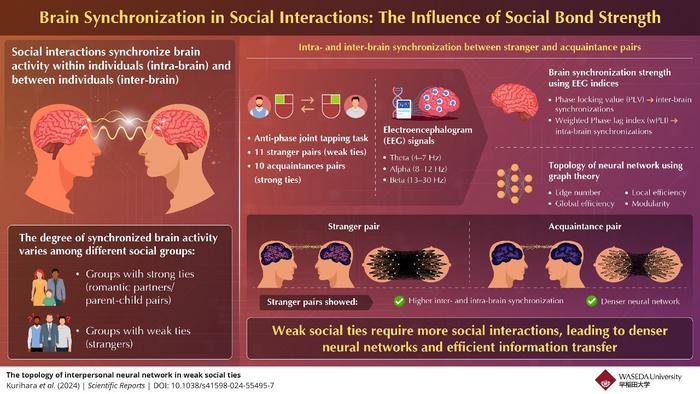We experience the world and connect with others through social interactions. Engaging in activities, such as conversations, cooperative tasks, and intimate relationships, deeply affect brain activity leading to coordinated neural activity within an individual’s brain (intra-brain synchronization) and between the brains of multiple individuals (inter-brain synchronization).

Credit: Yuto Kurihara from Waseda University
We experience the world and connect with others through social interactions. Engaging in activities, such as conversations, cooperative tasks, and intimate relationships, deeply affect brain activity leading to coordinated neural activity within an individual’s brain (intra-brain synchronization) and between the brains of multiple individuals (inter-brain synchronization).
Researchers study brain synchronizations to understand the neural processes behind social behaviors. This knowledge can help diagnose and treat conditions like social anxiety and communication-related disorders. However, investigations on brain synchronization have primarily focused on groups with strong social ties, such as romantic couples and parents and children.
In a study published in Scientific Reports on February 29, 2024, researchers from Waseda University in Japan reveal that cooperative interactive tasks between individuals with weak social ties result in more synchronized brain activity compared to individuals with strong ties.
“Our findings challenge the conventional understanding that stronger social ties predict greater brain synchronization and offer fresh insights into neural networking during social interactions,” says lead researcher Dr. Yuto Kurihara, Research Associate at the Faculty of Human Sciences at Waseda University.
The research team also included Dr. Toru Takahashi from the Advanced Research Center for Human Sciences and Professor Rieko Osu from the Faculty of Human Sciences at Waseda University.
They studied 14 pairs of strangers who met for the first time and 13 acquaintance pairs, in which one participant brought their partner. Due to artifacts, 21 pairs were included in the analysis (stranger pairs: 11, acquaintance pairs: 10). The participants were given a joint tapping task, where they had to tap a mouse button in opposite rhythms. Each participant wore earphones to hear both their taps and their partner’s taps, and they had to anticipate their partner’s movements.
Brain activity was captured using electroencephalograph (EEG) electrodes placed on their scalp for four tapping conditions: slow tapping with a 0.5-second interval, fast tapping with a 0.25-second interval, tapping freely at their preferred frequency, and tapping coordinated with a metronome at 0.50-second intervals (a pseudo condition). The study investigated how brain signals synchronize across the theta (4–7 Hz), alpha (8–12 Hz), and beta (13–30 Hz) frequency bands.
EEG analysis revealed that pairs of strangers exhibited greater intra-brain synchronization in the theta band, compared to acquainted pairs. Furthermore, binary undirected graphs constructed to represent the connectivity between EEG channels showed that the neural network was more densely connected in strangers than in acquaintances.
“Surprisingly, despite having weaker social ties, stranger pairs demonstrated more robust intra- and inter-brain EEG networks than acquainted pairs,” comments Dr. Kurihara.
Researchers suggest that the lack of familiarity between strangers requires a more involved process for predicting each other’s actions or behaviors in a cooperative task. Consequently, this heightened engagement leads to a more efficient transfer of information between closely connected nodes within the neural network.
This finding underscores the importance of weak social ties in shaping social relationships and individual behavior. “By demonstrating that strangers exhibit heightened intra- and inter-brain synchronization, our research highlights the potential of weak ties in fostering new connections and understanding the neural underpinnings of social interactions,” says Dr. Kurihara.
***
Reference
Authors: Yuto Kurihara1, ToruTakahashi2 & Rieko Osu3
Title of original paper: The topology of interpersonal neural network in weak social ties
Journal: Scientific Reports
Affiliations
- Graduate School of Human Sciences, Waseda University
- Advanced Research Center for Human Sciences, Waseda University
- Faculty of Human Sciences, Waseda University
About Waseda University
Located in the heart of Tokyo, Waseda University is a leading private research university that has long been dedicated to academic excellence, innovative research, and civic engagement at both the local and global levels since 1882. The University has produced many changemakers in its history, including nine prime ministers and many leaders in business, science and technology, literature, sports, and film. Waseda has strong collaborations with overseas research institutions and is committed to advancing cutting-edge research and developing leaders who can contribute to the resolution of complex, global social issues. The University has set a target of achieving a zero-carbon campus by 2032, in line with the Sustainable Development Goals (SDGs) adopted by the United Nations in 2015.
To learn more about Waseda University, visit
About Dr. Yuto Kurihara
Yuto Kurihara earned his Ph.D. in Human Sciences from Waseda University and currently serves as a research associate at the Faculty of Human Sciences. With expertise in social and cognitive neuroscience, his research focuses on the neural mechanism during social interaction. Dr. Kurihara is an active member of professional organizations like the Japanese Society for Neuroscience.
Journal
Scientific Reports
Method of Research
Experimental study
Subject of Research
People
Article Title
The topology of interpersonal neural network in weak social ties
Article Publication Date
29-Feb-2024
COI Statement
The authors declare no competing interests.



